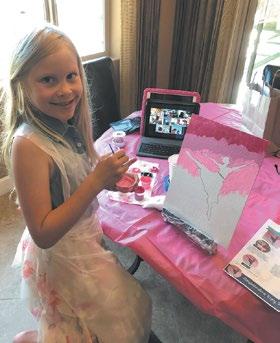HEALTH
MAY IS SKIN CANCER AWARENESS MONTH: TIPS TO SPOT SKIN CANCER EARLY
By Dr. Pablo Prichard
W
hile skin cancer is the most common cancer in the U.S., when caught early it is almost always curable. There are two different types: melanoma and nonmelanoma, which includes basal cell and squamous cell carcinoma. By learning these early signs, you’ll be able to catch cancer in its most treatable stage.
• Border: If a spot that was once round is now blurred or jagged, it should be looked at by a doctor. • Color: A mole should be one color. Any lightening or darkening could be a sign of cancer. • Diameter: Any growth larger than a pencil eraser should be examined even if there aren’t other abnormalities. • Elevation: Look for growths that have an uneven surface or irregularity.
MAY IS... SKIN CANCER AWARENESS MONTH
MELANOMA This is the deadliest form of skin cancer, making it the most important to be aware of. Melanoma can be found anywhere on the body but is most common in areas exposed to the sun including the head, neck, upper back, torso and lower legs. It can appear suddenly or develop from an existing mole. The simplest way to spot melanoma is to follow the “ABCDE” rule. Keep these guidelines in mind when looking at a potentially cancerous area: • Asymmetry: Moles and freckles are typically symmetrical. Make note if the area is now irregular.
BASAL CELL CARCINOMA This skin cancer begins in the basal cells, which produce new skin cells as old ones die off. It typically appears as a slightly transparent bump on the skin but can also present in other forms. The following could also be signs of basal cell carcinoma: flat, firm, pale areas like a scar; raised red patches, and small translucent bumps that are pink or red or a pearl-like shine. SQUAMOUS CELL CARCINOMA Squamous cells make up the outer layer of the skin. This type of cancer often looks like scaly
3254 East Cactus Road Phoenix, AZ 85032 602-867-9898 www.themendingspot.com
patches or raised growths similar to warts with a lower area in the center. Squamous cell carcinoma is more likely to grow deep and spread locally, causing tissue destruction, so catching it early is key to a quick recovery. Make it a goal to examine your skin once a month. If you see an area that concerns you, such as any new spots, a sore that won’t heal, or a growth that is itchy, painful or tender, share that with your doctor immediately even if you think it may not be serious. People with lighter skin are more susceptible to skin cancer than people with darker skin, as melanin, the pigment in the skin, is somewhat protective. Still, everyone should avoid the sun as much as possible and wear sunblock when outside. Pablo Prichard, M.D. has been the Chief of Plastic Surgery at HonorHealth John C. Lincoln Hospital for 14 years, Medical Director for Plastic Surgery and is Senior Partner at Advanced Aesthetics Associates. Dr. Prichard serves more than 2,000 patients every year and has specialized in both reconstructive and cosmetic procedures. For more information, visit drprichard.com and follow on Instagram @pabloprichard.
Inspiring Community Through Connections
Se Habla Español
We are a Veteran Owned Integrated Medical, Chiropractic Clinic.
WE OFFER A WIDE VARIETY OF SERVICES: Full Chiropractic Spine Care Orthopedic Care Non-Narcotic Pain Management YOU’RE INVITED! HEALTH TALKS & SNACKS Join us the last Wednesday of each month at 6:00 p.m. for a health presentation on a variety of topics. Snacks and beverages will be provided.
$99.00 SPECIAL
Sports Injuries Personal Injuries Work Place Injuries Treat Diabetic Neuropathy Massage Therapy
Includes Examination, X-Rays, Consultation, One Chiropractic Adjustment & One Medical Pain Management Consultation.
8 • May 2020 • NORTH 32ND NEWS
“My greatest joy is helping people find a safe and comfor table place to call home.” AZBR 654152000 | CABRE 01849212
Loveajb.com north32ndnews.com









